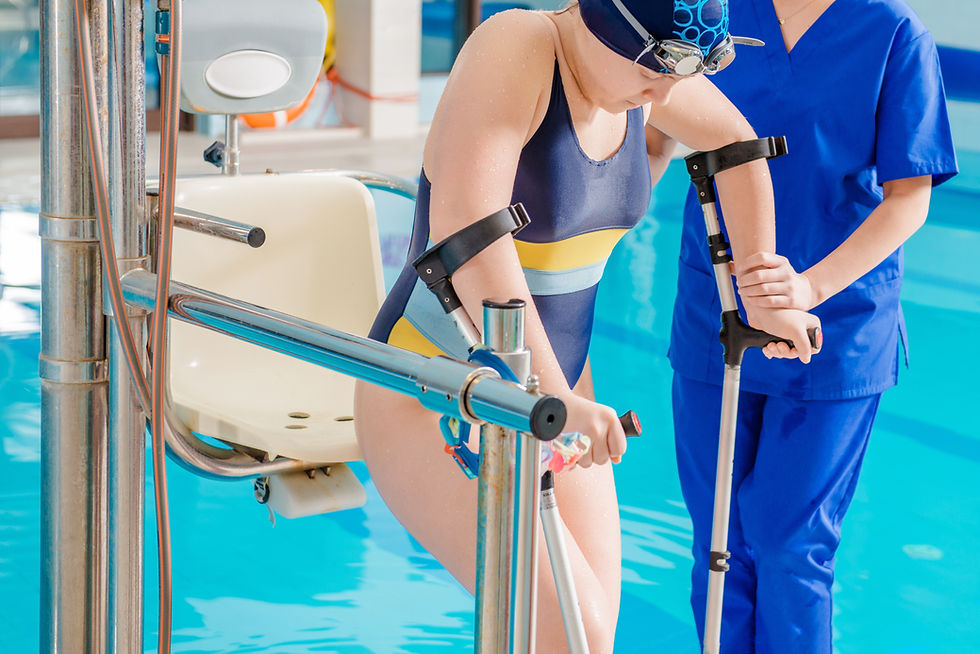Pool Types. And Why it Matters.
- Sage Leif
- Dec 24, 2023
- 2 min read
Understanding the different types of pools is crucial for operators. Pool classifications are constantly under review. More intricate classifications, definitions, and regulations are needed to meet the ever-growing list of different types of recreational water facilities. Certified Pool Operators should know the regulations, classifications, and definitions covering their facility. This article dives into the various classifications of pools.
Types of Pools
Recreational water facilities have two basic categories: commercial (or public) and residential (or private).
Residential Pools

A pool intended for use as an added accessory to a residential setting and available only to the household and its guests. Residential pools have 2 types: Types I-V (suitable for installing diving equipment) and Type O (a non-diving residential pool).
Commercial/Public Pools
Commercial pools are typically defined as any pool other than a residential one intended to be used for swimming or bathing and operated by an owner. Fees do not need to be charged for a pool to be classified as a commercial or public pool. Public pools can be divided into Type VI-IX (pools suitable for the installation of diving equipment) and Type O (non-diving pools), and further categorized into the following "Classes":

Class A (Competition Pool)
Purpose: For accredited competitive aquatic events (e.g., FINA, NCAA).
Usage: Often used for training and competitive swimming events.

Class B (Public Pool)
Purpose: General public recreational use.
Usage: Typically found in community centers and public recreational facilities.

Class C (Semi-Public Pool)
Purpose: Exclusive use with lodging facilities like hotels, HOAs, apartments, etc.
Usage: Aimed at providing amenities for residents and guests.

Class D (Specialized Pools)
These pools are designed for specific recreational activities:
a) Class D-1 (Wave Action Pool)
Feature: Simulates breaking or cyclic waves.
Usage: Popular for general play or surfing simulation.
b) Class D-2 (Activity Pool)
Feature: Designed for casual water play and attractions.
Usage: Offers a range of playful activities, from splashing to interactive games.
c) Class D-3 (Catch Pool)
Feature: A body of water that a water slide terminates at.
Usage: Ensures a safe landing and exit for slide users.
d) Class D-4 (Leisure River)
Feature: A manufactured, flowing stream.
Usage: Provides a river-like experience, often including water features and play devices.
e) Class D-5 (Vortex Pool)
Feature: Circular design with water propulsion.
Usage: For riding and experiencing water currents.
f) Class D-6 (Interactive Play Attraction)
Feature: Water-based play devices with varied flows and pressures, such as slides, climbing structures, etc.
Usage: Encourages interactive, bather-driven play.

Class E (Therapy Pool)
Temperature: Above 86ºF (30°C).
Usage: For instruction, play, or therapy.

Class F (Wading Pool)
Purpose: Specifically for wading, often for children.
Usage: Common in family and community settings.
Importance of Qualified Pool Operators
Pool classifications are subject to ongoing review and vary across local regulations. Certified Pool/Spa Operators (CPOs) must be knowledgeable about these nuances and should be aware of the regulations and definitions that cover their faculty. Their expertise is vital in:
Ensuring Compliance: Adhering to state and local health and safety regulations.
Maintaining Standards: Overseeing water quality, facility maintenance, and safety protocols.

Conclusion
The classification of pools serves as more than just a bureaucratic necessity; it's a framework that guides the safe and enjoyable use of aquatic facilities. As innovations in pool design continue, the role of the qualified pool operator becomes increasingly vital in bridging the gap between regulatory standards and user experience. This intricate classification system underscores the diverse nature of aquatic facilities and the importance of their proper management for the safety and enjoyment of all.

Comments